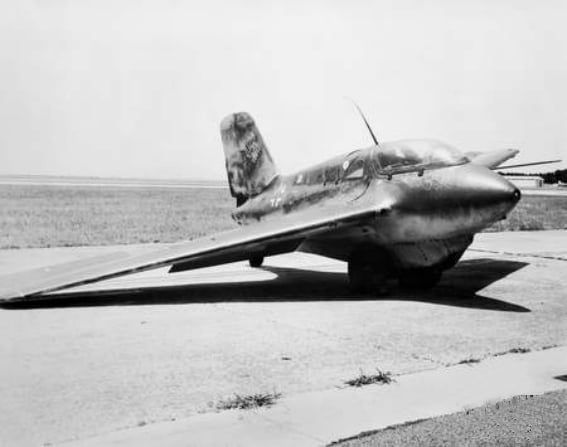The Fighter American Pilots Dubbed Too Fast to Hit in Combat During WWII

U.S. Army Air Force P-47 fighter pilot while in combat., Public domain, via Wikimedia Commons
During the closing years of the war in Europe, American bomber crews faced many threats in the skies. But nothing shocked them more than a rocket-powered interceptor that moved faster than anything they had ever seen. Many described it as impossible to track and nearly impossible to hit. This article looks at how that aircraft came to be, how it performed in combat, and how both sides recalled their experiences with it.
The First Encounters
On July 28, 1944, over Leipzig, American B-17 crews witnessed a new threat. A small interceptor climbed almost straight upward, driven by the reaction of hydrogen peroxide and hydrazine mixtures. It closed the distance at more than 500 miles per hour, fired its cannons, and disappeared within seconds. American gunners tried to respond, but the aircraft’s speed made aiming nearly useless. Many airmen later said it was simply too fast to hit.
During this raid, a German pilot named Siegfried Schubert claimed to have struck two bombers during a single pass. Whether each claim was accurate or not remains debated, but the effect on the American crews was not. They reported seeing one bomber break apart in midair as its wing separated, forcing its crew to parachute into open sky. The rocket fighter, its fuel spent within minutes, drifted back to its airfield while American airmen tried to make sense of what they had seen.

How the Aircraft Was Designed
To understand why this interceptor behaved so differently, historians trace its design back to the late 1930s. German engineer Alexander Lippisch had long studied tailless gliders, believing their smooth shapes would reduce drag and improve speed. By 1937, he added rocket propulsion to these concepts, experimenting with early test beds and modified gliders. The work escalated as war approached, and by 1939 his team joined the Messerschmitt company to develop the design further.
Early test flights of the first prototype series took place in 1941. The aircraft used a rocket engine that produced strong thrust but lasted only a short time. Because of this, it acted more like a high-speed strike weapon than a normal fighter. A simplified production model soon followed, using wooden wings, a metal fuselage, and two large 30-millimeter cannons. It launched from a wheeled cart that dropped away and landed on a skid. By 1944, around 370 examples were built, fewer than planned due to bombing, shortages, and limited resources.
Preparing for Combat
Operational testing began in 1943 and expanded the following year. Pilots trained in unpowered gliders to understand the tailless layout, then practiced in altitude chambers to prepare for thin air at high levels. Strict diets were even enforced to reduce stomach problems in the unpressurized cockpit. The first combat attempt took place in May 1944, when one aircraft tried to intercept a British Mosquito. The Mosquito escaped, but the mere appearance of the rocket plane drew attention from Allied intelligence.
In July 1944 a dedicated interceptor group was formed near Leipzig, with the job of defending fuel plants. Crews watched radar screens for incoming bomber raids. When alerts sounded, the rocket fighters launched in pairs or small groups. Their climb rate exceeded 80 meters per second, allowing them to reach bomber formations within minutes. The tactic was simple: climb above the bombers, dive through the formation at high speed, fire a short burst, then glide back to base.

Combat Experience and Human Cost
American escort fighters could not catch the rocket interceptors in the dive, but they learned to attack them during landing. Several were destroyed on the ground in August 1944. Pilots also faced the danger of the fuel itself, which could dissolve organic material and caused many fatal accidents. Training deaths were frequent. Ground crews wore protective suits, yet pilots had little protection inside the cockpit.
Personal accounts from both sides describe the aircraft’s unusual abilities. German test pilots wrote of its sharp handling during glides but also spoke of crashes caused by landing gear failures or fuel issues. A female test pilot suffered severe injuries when her takeoff cart failed to release, yet she continued to send feedback urging improvements. After the war, British test pilot Eric Brown flew a captured example and described the steep climb as almost overwhelming, though he noted the constant risk of explosion. Letters from wartime pilots show a mixture of fear, duty, and isolation. One German pilot described firing once at a bomber before losing all power and praying the landing skid would hold on the return.
By late 1944 fuel shortages limited operations, and new upward-firing weapons appeared only months before the end. The final confirmed success came in April 1945. Soon after, the unit surrendered as the front lines collapsed. About nine to eighteen Allied aircraft were destroyed in total, while many rocket fighters were lost to accidents. More than twenty pilots died in training or mishaps.
After the war, captured examples were studied in the United States, Britain, and the Soviet Union. Tests confirmed the aircraft’s speed but also its extreme risk. Other nations explored rocket propulsion, but jet aircraft soon replaced the idea. Today, surviving examples stand in museums as reminders of a design that pushed far past the limits of the time and cost many lives in the process.




















